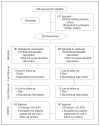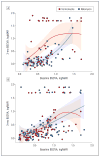The mycotic ulcer treatment trial: a randomized trial comparing natamycin vs voriconazole
- PMID: 23710492
- PMCID: PMC3769211
- DOI: 10.1001/jamaophthalmol.2013.1497
The mycotic ulcer treatment trial: a randomized trial comparing natamycin vs voriconazole
Abstract
Objective: To compare topical natamycin vs voriconazole in the treatment of filamentous fungal keratitis.
Methods: This phase 3, double-masked, multicenter trial was designed to randomize 368 patients to voriconazole (1%) or natamycin (5%), applied topically every hour while awake until reepithelialization, then 4 times daily for at least 3 weeks. Eligibility included smear-positive filamentous fungal ulcer and visual acuity of 20/40 to 20/400.
Main outcome measures: The primary outcome was best spectacle-corrected visual acuity at 3 months; secondary outcomes included corneal perforation and/or therapeutic penetrating keratoplasty.
Results: A total of 940 patients were screened and 323 were enrolled. Causative organisms included Fusarium (128 patients [40%]), Aspergillus (54 patients [17%]), and other filamentous fungi (141 patients [43%]). Natamycintreated cases had significantly better 3-month best spectacle-corrected visual acuity than voriconazole-treated cases (regression coefficient=0.18 logMAR; 95% CI, 0.30 to 0.05; P=.006). Natamycin-treated cases were less likely to have perforation or require therapeutic penetrating keratoplasty (odds ratio=0.42; 95% CI, 0.22 to 0.80; P=.009). Fusarium cases fared better with natamycin than with voriconazole (regression coefficient=0.41 logMAR; 95% CI,0.61 to 0.20; P<.001; odds ratio for perforation=0.06; 95% CI, 0.01 to 0.28; P<.001), while non-Fusarium cases fared similarly (regression coefficient=0.02 logMAR; 95% CI, 0.17 to 0.13; P=.81; odds ratio for perforation=1.08; 95% CI, 0.48 to 2.43; P=.86).
Conclusions: Natamycin treatment was associated with significantly better clinical and microbiological outcomes than voriconazole treatment for smear-positive filamentous fungal keratitis, with much of the difference attributable to improved results in Fusarium cases.
Application to clinical practice: Voriconazole should not be used as monotherapy in filamentous keratitis.
Trial registration: clinicaltrials.gov Identifier: NCT00996736
Conflict of interest statement
Figures


References
-
- Chang DC, Grant GB, O’Donnell K, et al. Fusarium Keratitis Investigation Team. Multistate outbreak of Fusarium keratitis associated with use of a contact lens solution. JAMA. 2006;296(8):953–963. - PubMed
-
- Khor WB, Aung T, Saw SM, et al. An outbreak of Fusarium keratitis associated with contact lens wear in Singapore. JAMA. 2006;295(24):2867–2873. - PubMed
-
- Margolis TP, Whitcher JP. Fusarium: a new culprit in the contact lens case. JAMA. 2006;296(8):985–987. - PubMed
Publication types
MeSH terms
Substances
Associated data
Grants and funding
LinkOut - more resources
Full Text Sources
Other Literature Sources
Medical

